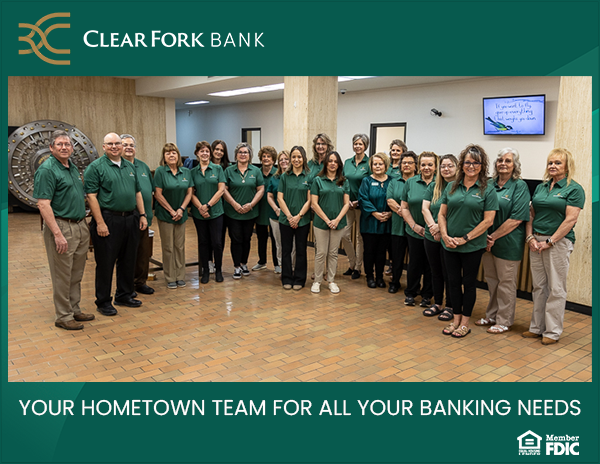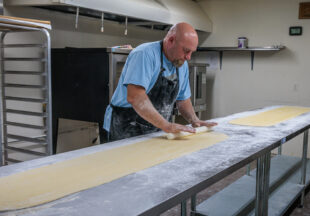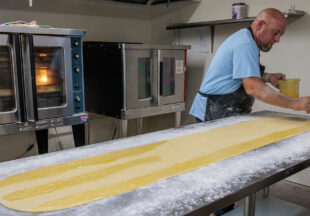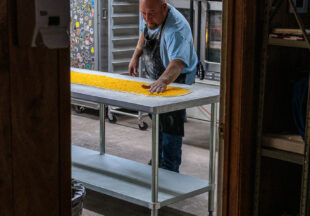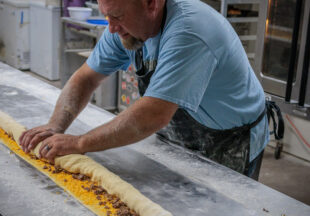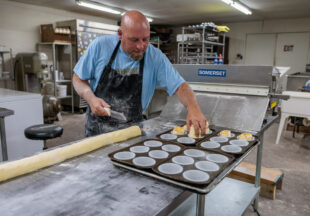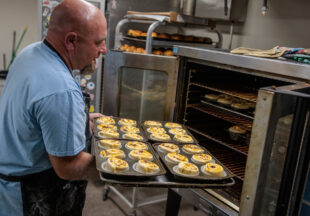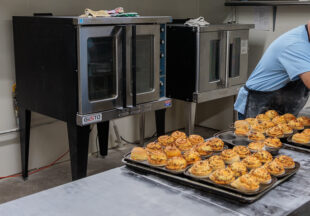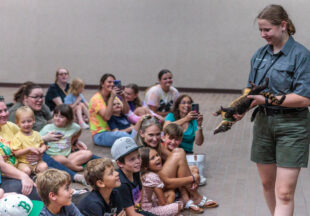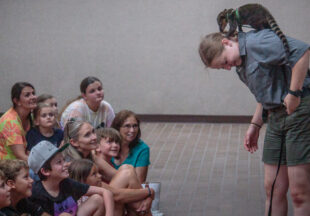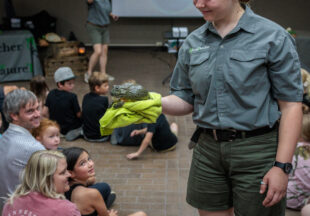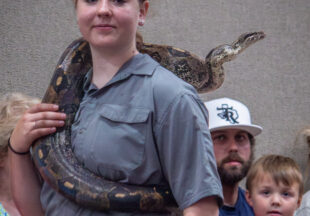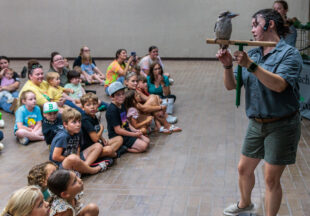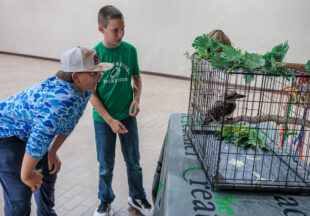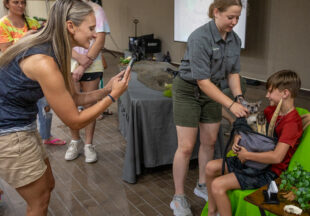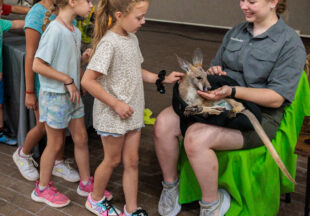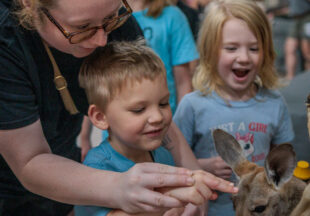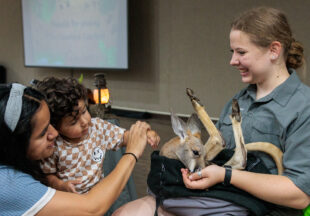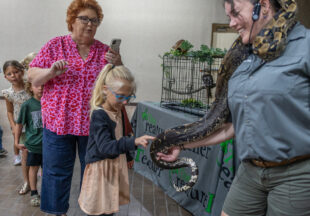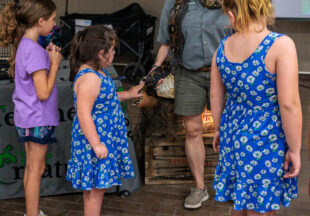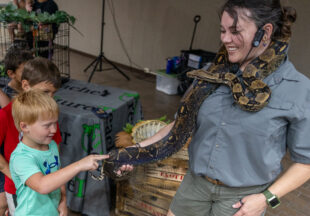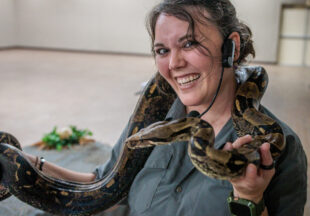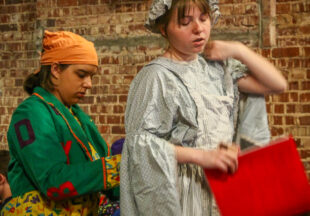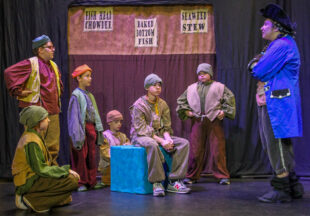Stephens County gets all negative results after high turnout for drive-through COVID-19 testing

On Saturday, the results from last week’s mass COVID-19 testing came back, and all 96 tests were negative. That makes Stephens County the first in the state to have no positive tests in the drive-through testing program, according to reports from officials.

A member of the National Guard directs traffic at the mass testing site in Stephens County on April 30. Ninety-six residents were tested, and all of the results came back negative for COVID-19. (Photo by Tony Pilkington/Breckenridge Texan)
The testing was conducted on Thursday, April 30, by a team of National Guard members who are traveling around the state to test large groups of people in communities that don’t necessarily have the resources for massive testing on their own. It was offered free to anyone in the community who wanted to get tested, regardless of symptoms, risk factors or insurance.
Some counties that tested just a few people may have had no positives, but in counties with a large number of residents tested, Stephens County is the only one with all negative results.
Compared to several other rural counties, Stephens County had a high turnout on Thursday, a fact that Stephens County Judge Michael Roach attributed to successfully getting the word out to the community and to local residents being willing to get tested. Those getting tested included a wide range of people, including local business owners, essential workers, elderly citizens, first responders and others, he said.
In addition to Thursday’s mass testing, the hospital and medical clinics have tested 43 people. As of Saturday, May 2, in Stephens County, there have been a total of 139 COVID-19 tests conducted with one positive result, 135 negative results and three tests still pending.
For more details on the process at Thursday’s testing, check out the section at the end of this article with the subtitle “A first-person view of the testing process.”
Click here to read the Breckenridge Texan’s previous article about the National Guard testing.
What the results mean
While the test results indicate that there has not been a lot of community spread of the disease caused by the novel coronavirus in Breckenridge and Stephens County, the results should not create a false sense of security, Roach said.
“I do think that, at some point, we’re going to have more positive tests,” he said. “I don’t want people to feel that there’s never going to be anybody else in Breckenridge who has a case of COVID-19, that it’s just going to disappear. … We shouldn’t let our guard down, especially if you’re immunocompromised or if you’re in that high-risk category. You should just, not live in fear, but you should live cautiously and not take any chances.”
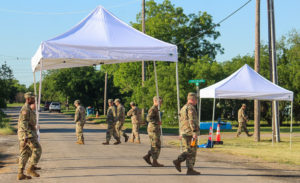
Members of the National Guard set up tent-awnings in Breckenridge on Thursday, April 30, in preparation for the mass COVID-19 testing. (Photo by Tony Pilkington/Breckenridge Texan)
Roach said he has reached out to the local stores and asked them to continue to have special shopping hours for senior citizens or those who are immunocompromised. Some businesses are also continuing to offer drive-up or curb-side services for those who are in a high-risk category and are uncomfortable shopping in public.
“I think we need to continue to do that,” he said. “We cannot let those test results lull folks into thinking there’s a place where COVID-19 does not exist. That’s just not going to be the case. We’ve already had one case locally, and I want people to be prepared when there’s another positive case that happens somewhere down the road.”
Roach said that he continues to believe that each community needs to move forward based on the local and regional resources that they have.
Over the past few weeks, he explained, Stephens County residents sheltered in place as much as possible, allowing the hospital, clinics and other entities to prepare so that the community will be able to handle several cases of COVID-19, if more local citizens contract the virus.
The actions that were taken were a way to buy time and not let the disease spread so fast that it overwhelmed the community’s resources, he said.
“It was a tool that you only use for a period of time until you get capacity (to handle potential cases of the disease), which is what I think we have,” Roach said. “Regionally, Abilene has capacity; Fort Worth has capacity; north of us, in Wichita Falls, has capacity. So, we have capacity to transfer somebody out, and that was our concern originally. For now, we have capacity. And, then there’s federal resources in Texas. They can set up a hospital in a matter of a few days that has 1,000 beds, all with ventilators. So, we’re in a good place right now. That’s why I think we should open our local economy back up, but let’s be smart about it.”
Additionally, he said, the community now has the ability to trace a COVID-19 patient’s contacts so that they can notify anyone who might have been exposed to the disease.
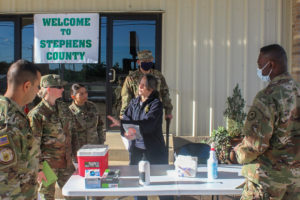
Sondie Epley with the Texas Emergency Task Force, center, goes over the testing procedures with members of the National Guard before Thursday’s mass testing in Breckenridge. (Photo by Tony Pilkington/Breckenridge Texan)
Future testing
Stephens County has the opportunity to offer another mass testing program, and Roach said he will talk to local health officials before deciding when that will be.
“We want to use that resource wisely and for purpose,” he said. “We felt like, with this last test, we didn’t have a mechanism for asymptomatic people, people that didn’t know they were sick, to be tested. Anybody could be tested last Thursday. It was for anybody.”
The negative test results reassured officials that the community doesn’t have a lot of community spread going on, Roach said.
“What will guide us (to schedule another mass testing) is if we start seeing a lot of symptomatic people showing up at the ER or clinic, an uptick…if we have another case,” he said. “The (National Guard) teams will be available for a while. We’re going to let public health and our doctors lead us, when to do that.”
A first-person view of the testing process
Note: Breckenridge Texan Editor Carla McKeown had the COVID-19 test on Thursday, April 30, at the National Guard’s drive-through testing site in Breckenridge. Here is her first-hand account of the process:
Wednesday, April 29: I spent 30 minutes on the phone to schedule the testing. Most of that time was on hold. I heard that others were waiting anywhere from 15 minutes to more than an hour. Once I was connected with a person, she asked me some basic information, such as my name, address, phone number, and then went through the list of COVID-19 symptoms. Although I didn’t have symptoms, I was allowed to make an appointment. I was informed that only one person per household could be tested during the one-day testing program. I was assigned a spot at 2:05 p.m. on Thursday.
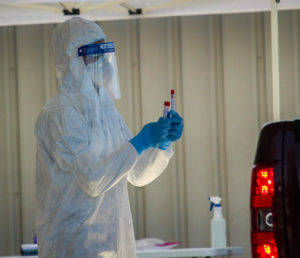
A medic with the National Guard prepares to administer a COVID-19 test to a local resident at the drive-through testing site in Breckenridge on Thursday, April 30. (Photo by Tony Pilkington/Breckenridge Texan)
Thursday, April 30: I showed up at 2 p.m. and got in line behind 10 other vehicles. I could see two tent-awnings set up ahead of me, each staffed by several National Guard members in uniform and face masks. At the first station, my name was verified on a checklist by one of the National Guard members.
The line was moving slowly, and about 25 minutes later, I got to the second station. There, a man in head-to-ankle protective gear, including a face mask and shield and gloves, asked me to show my ID. He gave me some basic information about COVID-19, along with a disposable face mask. I was also given a tissue and instructed to blow my nose.
About 5 minutes later, it was my turn to drive up to the actual testing site. There, another man in protective gear approached my car and instructed me to keep my window closed but to open the door as wide as it would open. I was to keep my feet facing forward and to turn my upper body toward him. He confirmed my name and date of birth and asked me to lower my mask just below the nostrils.
He took a long swab out of a test tube-type container and let me know that he would be testing both nostrils. He inserted the swab into one nostril and then back toward my throat and then into the other nostril. I experienced a slight burning sensation in my throat and that same feeling you get when you inhale water through your nose when you’re swimming. My eyes watered, but, to be honest, the pain was brief and short-lived. Basically, as soon as the swab was removed, the discomfort in my nose ended. The burning in my throat lasted maybe 5 minutes.
The medic doing the test was polite and comforting throughout the procedure. When he had bagged my swab to be tested, he turned and gave me the thumbs-up to leave.
I’ve had a flu test before, and the COVID-19 test didn’t seem as bad as that. But, it’s basically the same type of procedure.
I would say that having the test done was worth the discomfort.
Saturday, May 2: I received an automated robo-call informing me that my test results were negative. I also received a text message with a link to a letter explaining my results and what to do if I have COVID-19 symptoms in the future.
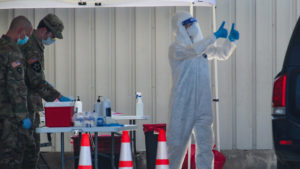
After securing the testing swabs, the National Guard medic gives the thumbs up to the tested resident, indicating that their test was complete and they could leave. (Photo by Tony Pilkington/Breckenridge Texan)
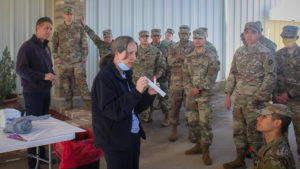
Sondie Epley, center, and Joe Palfini, left, with the Texas Emergency Task Force talk to National Guard members about the testing procedure. (Photo by Tony Pilkington/Breckenridge Texan)
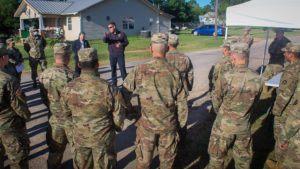
National Guard members listen to instructions before the COVID-19 testing began in Breckenridge on Thursday. The local event was the first for many of the guard members. (Photo by Tony Pilkington/Breckenridge Texan)
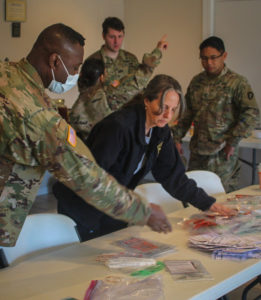
Lt. Col. Alton Stewart, with the MEDCOM Texas Army National Guard in San Antonio, and Sondie Epley, with the Texas Emergency Task Force, organize the COVID-19 testing materials before Thursday’s event in Breckenridge. (Photo by Tony Pilkington/Breckenridge Texan)
Story by Carla McKeown and Tony Pilkington/Breckenridge Texan
Cutline, top photo: A National Guard medic gives a Stephens County resident a COVID-19 test on Thursday, April 30. All of the 96 tests came back with negative results. (Photo by Tony Pilkington/Breckenridge Texan)




